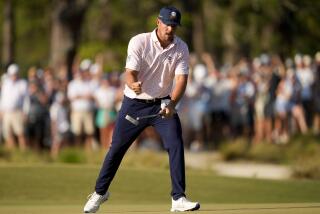THE U.S. OPEN : Only Weather Is Below Par as Tway Leads
- Share via
SOUTHAMPTON, N.Y. — Bob Eaks, a professional golfer from Colorado Springs, was the first player to tee off Thursday in the 86th United States Open.
He set the pace for the day, shooting a 40-45--85 that included a triple-bogey 8.
Shinnecock Hills, beefed up by a daylong Nor’easter that swept a chill wind across the weather-beaten fairways, did not give up a single subpar round.
Its par 70 was inviolate. Only Bob Tway, last week’s winner at Westchester, was able to match par on the storied course that lies near the eastern tip of Long Island.
Not since the opening round at Winged Foot in 1974 has there been a round in the U.S. Open in which no golfer broke par. Gary Player was the only one to match par 70 on that day.
“It was as difficult a day as I have ever seen in an American championship,” Jack Nicklaus said of Thursday’s round. Nicklaus is playing in his 30th U.S. Open.
It was the kind of a day on which Nicklaus made three double bogeys on the back nine for a seven-over-par 77 and still said, “I’m in as good a position after the first round as I was at Augusta.”
It was at Augusta in April that the 46-year-old Nicklaus came back from an opening 74 to win the Masters and his 20th major championship.
It was also the kind of a day where the whitecaps on Peconic Bay were as high as the scores.
The carnage strewn across the sand dunes of Shinnecock Hills included such shocking scores as an 85 for Jack Renner, an 83 for Danny Edwards and 80s for Corey Pavin, Jay Haas and Miller Barber.
High for the day was an 88 by amateur John Daly of Dardanelle, Ark.
They were among 37 of the 137 finishers who failed to break 80.
There may be more. Eighteen players were left on the course after 12 hours 53 minutes of golf between Eaks’ first tee shot at 7 a.m. and Bobby Clampett’s final putt at 7:53 p.m. The 18 will finish their first round this morning before taking off for another 18 in the afternoon.
Among those still on the course was Don Dubois, a young non-touring pro from Glendora, who was only four over par after 16 holes.
Thursday’s average score was 77.55 strokes.
“Today was just kind of a survival day,” Tway said after making 4 birdies, 4 bogeys and 10 pars.
One shot behind Tway, a two-time winner this year, was the tournament favorite, Australia’s Greg Norman, with a 71.
“I think my 71 today was like shooting a 67, or even a 66, under good conditions,” Norman said.
Six players finished at 72--Kenny Knox, David Frost, Rick Fehr, Tommy Nakajima and the Watsons, Tom of Kansas City and Denis of South Africa.
“I loved it,” Tom Watson said. “This is my favorite condition for golf. It’s like a nice winter day in Kansas City, and I’m very satisfied with my 72.”
Most of the other players who struggled to control their nerves, their tempers and their shots in the winds that gusted up to 30 m.p.h. were not so charitable.
“It was like a British Open day--a bad one,” Nicklaus said. “I said early in the week that I didn’t mind the wind, but I didn’t mean like this. “
Nicklaus was rolling along, one over par and quite pleased with his play, when he came to the 10th hole, a 409-yard par-4 that seems so passive when seen from the tee.
A gust of wind caught Nicklaus on his backswing and caused him to hit the ball far to the right of the fairway. No one seemed to know exactly where it landed--including Jack himself, his caddy son Jackie, or a U.S. Golf Assn. official.
It was an unusual sight, Nicklaus, head bowed, peering down at the ground like a duffer at Industry Hills.
Several hundred spectators joined the search, trampling the wheatgrass, scrubby bushes and low-lying undergrowth trying to save Nicklaus a two-stroke, lost-ball penalty.
All to no avail--until it was too late.
Just as Nicklaus headed back up the hill toward the tee to hit another shot, a spectator found the ball. Nicklaus started back down the hill, then hesitated as he figured he was close to the five minutes permitted to search for a lost ball, and turned back toward the tee.
He hit a second ball and holed out after four strokes for a 6, counting the penalty.
“There was a USGA official there and he didn’t tell me I had time until later, when it was too late,” Nicklaus said. “He said I still had about 30 seconds, but from what Jackie told me about where the ball was found, I probably wouldn’t have made better than a six anyway. It was at least 40 yards right of the fairway.”
The last ball he could remember losing in a major tournament, Nicklaus said, was clear back in the 1958 British Amateur.
Nicklaus’ two other double bogeys resulted from missed short putts. He took three putts from 12 feet on No. 13 and missed a three-footer on No. 18 after chipping from the rough.
“I only hit four greens and had 27 putts, including the three-putt green, so I’m happy with my 77,” he said. “I know one thing--I never played a major tournament before where I only hit four greens.”
The most puzzling aspect of Thursday’s wintry conditions was not so much the cold as the fact that the wind was directly opposite to what it had been during the week’s practice days.
“The wind came from the southeast all week, and today we come out here and it’s coming from the other direction,” Norman said. “It made for some dramatic changes in club selection and lining up our targets off the tee. It was a whole new golf course for us.”
The change made the 9th and 18th holes, both 450-yard par-4s, impossible to reach in two shots but shortened up No. 6, a 471-yard par-4, dramatically.
“I used a 1-iron for my second shot at No. 6 in all my practice rounds,” Tom Watson said. “Today, I hit a wedge.
“That’s the fun of a windy day, trying to negotiate the wind and put the ball where you want it. That’s why I like the British Open so much.”
Watson has won the British Open five times.
The British Open-like day didn’t help British Open champion Sandy Lyle of Scotland. He had a 78.
Tway was not only the lone player to shoot par, he was also the only player who never went over par. Twice he made a birdie, only to bogey the next hole, and when he made two birdies in a row to go two under par, he turned around and made consecutive bogeys.
“The main thing was to have a lot of patience,” said the former college player of the year from Oklahoma State. “You could really blow yourself out of the tournament today if you let the conditions get to you.
“I’ve played in worse conditions when I was in college, but not on this difficult a course. The 70 I shot might be the equivalent of a 65 on most courses.”
Tway’s most spectacular shot was a 102-yard pitching wedge on the eighth hole that left him a one-foot tap-in for one of his birdies.
Scott Verplank, another Oklahoma State golfer making his first professional start after winning the NCAA championship, had a commendable 75, making him one of 21 players at five over par.
U.S. Amateur champion Sam Randolph of Santa Barbara and USC, making his last start as an amateur before turning professional, had a 79, the same score as defending U.S. Open champion Andy North.
Renner and former Open champion Jerry Pate both withdrew, Renner after his 85 and Pate after shooting 6-8 on two holes where par was 4-4.
THE LEADERS
After 18 Holes
Bob Tway 35-35--70 Greg Norman 36-35--71 Kenny Knox 33-39--72 Tom Watson 38-34--72 Denis Watson 35-37--72 David Frost 35-37--72 Rick Fehr 37-35--72 Tommy Nakajima 36-36--72
Complete scores, Page 18.
More to Read
Go beyond the scoreboard
Get the latest on L.A.'s teams in the daily Sports Report newsletter.
You may occasionally receive promotional content from the Los Angeles Times.










